Variations: Lemon-Orange Scented Chiffon Cake; Mocha Chocolate Fleck Chiffon Cake
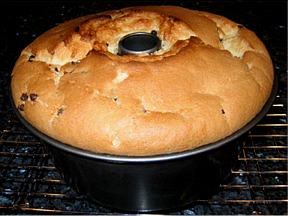
Chiffon Cakes are a member of the foam cake family; that is, they rely upon beaten egg whites to rise but also combine the richness of shortening-type cakes with egg yolks, leavening agents and vegetable oil.
I have created this chiffon cake to rise high – this one reaches heights of 5 to 5-1/2-inches! This cake is not too sweet, which is nice, and has bits of semi-sweet chocolate bits throughout. It's great served as is, or sprinkled with powdered sugar, with a simple side serving of peaches, garnished with a fresh sprig of mint.
These types of foam cakes take time to make properly. The goal in making a chiffon cake is to beat air into the egg whites and all the mixing and baking steps that follow are done to preserve the delicate air bubbles. Move quickly and delicately through all of the steps and place the batter in a hot, well-preheated oven so it can expand rapidly.
CAKE RECIPE HELP
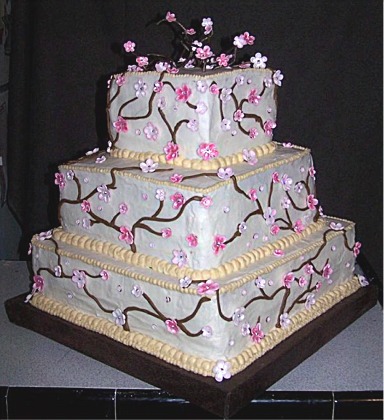
Cake and photo by txbaker26, Premium Member © Sarah Phillips
TXBAKER26, Premium Member, Says: “Thanks Sarah!!! Every recipe I have tried so far from yours has worked each and every time!!! My favorite and the one i get the most raves about is your chiffon recipe which i used it on this one to and everyone went on and on about how moist the cake was!!!”
INGREDIENTS
12 large eggs; separated (You'll need 12 egg whites and 12 egg yolks for the recipe)
1 3/4 cups bleached cake flour (not self-rising); spoon into dry measuring cup and level to top; DO NOT use a cake flour substitute.
1 tablespoon (3 teaspoons) baking powder
1/2 teaspoon salt
1 1/2 cups sugar or superfine sugar, divided in 3/4 cups and 3/4 cups
1/2 cup vegetable oil
3/4 cup water, cold
2 teaspoons vanilla extract
1/2 teaspoon cream of tartar
1/3 cup MINI chocolate chips or bittersweet and semi-sweet baking chocolate grated with a fine grater; grate and then, measure
Optional: powdered (confectioners') sugar, sifted
INSTRUCTIONS:
1. Preheat the oven and prepare the baking pans:
A. Position the oven rack in the lower third of the oven and preheat the oven to 350 degrees F.
Remove the top racks so the cake has enough room to rise at least an inch above the pan (pan is 4-inches tall).
SARAH SAYS: In my oven, it has six rungs. The beginning of the lower third, starts at the second rung from the bottom.
B. Use a light colored aluminum pan called an “Angel Food” Cake or Tube Pan that is 10- x 4-inches with a removable bottom. DO NOT use a non stick pan. Grease the bottom of the cake pan ONLY – DO NOT grease the sides.
SARAH SAYS: Many stores still call the pan a “tube” pan because of the tube in the center, but be sure to purchase a pan with a removable bottom. You need it to ensure the cake will come out smoothly. The cake needs to be inverted to cool, so do not use a non stick pan. You don't want the cake to fall out; it needs to stick to the sides when inverted.
For light-colored cake sides, use light, heavy aluminum pans (pictured below), not dark-colored ones.
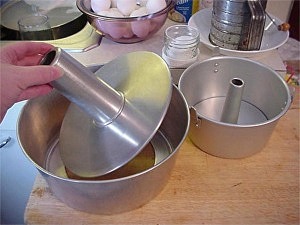
2. Make the cake batter: Prepare the batter mixture; add the wet ingredients in the well of the flour / dry ingredients in the following order without mixing…It is VERY important!
A. Combine the dry ingredients:
1. In large mixing bowl, preferably with a wide rim, sift together the flour, baking powder, and salt. Repeat two more times. If you don’t have a sifter, use a fine mesh strainer.
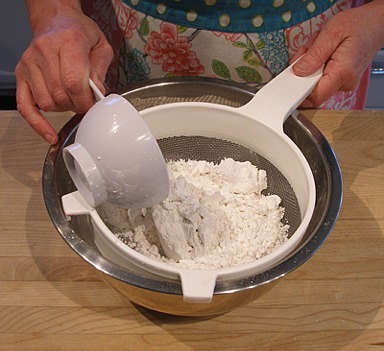
2. Add in 3/4 cup sugar. Whisk together to blend.
3. Make a well in the center of the flour mixture and set aside.
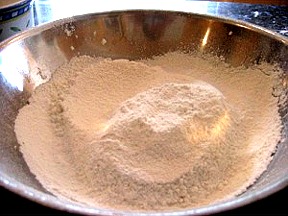
SARAH SAYS: The reason for layering the ingredients in a certain order before mixing helps form the batter properly. I have found, through my extensive testing of a wide variety of Chiffon Cake Recipes (and I mean extensive), that some failed while others didn't. I set out to find out why. I found that one of the biggest causes of failed Chiffon Cakes, besides the improper beating of egg whites and not properly folding the recipe together, is ALSO the improper formation of the cake batter (not written about anywhere — yes, you heard it here first!) Many recipes have you simply dump all of the batter's ingredients into the bowl without regard to order or mixing method, which you'll observe if you look through most cookbooks, leading to many failed recipes and unhappy bakers.
B. Prepare the batter mixture:
SARAH SAYS: In the well of the flour mixture, add the following, in order WITHOUT mixing.
1. Add the oil
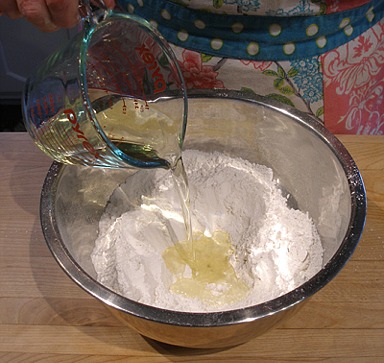
2. Add the 12 egg yolks;
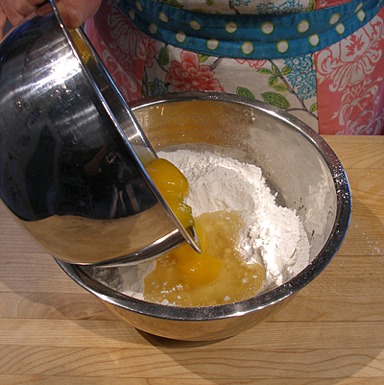
3. And, finally, the water and vanilla extract
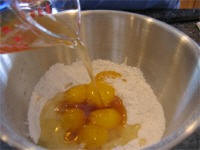
C. With a wire whisk, mix together the ingredients until smooth and light in color. It is critical that the resulting batter mixture is smooth and without lumps because when the cake bakes, the flour lumps will stay that way.
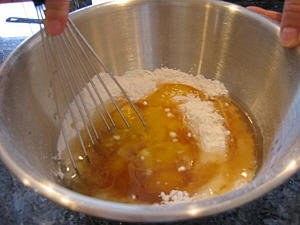
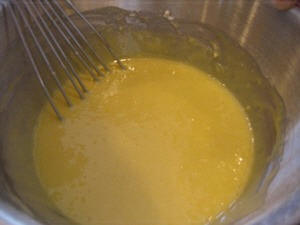
But, there will always be a few small flour lumps, so I advise straining the mixture through a fine mesh strainer by pushing the mixture through with the help of a rubber spatula to a large bowl below. Discard any flour lumps that are left in the strainer. Cover the batter with plastic wrap and set aside.
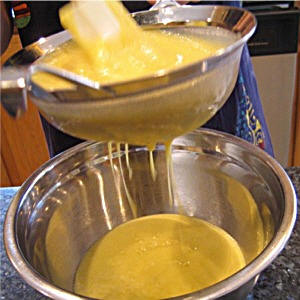
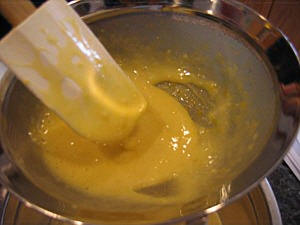
HELP! I had to throw away a lot of flour lumps. I'm worried that there isn't enough flour left for the recipe. What should I do?
SARAH SAYS: ONLY if there is a tablespoon or MORE of flour lumps left in the strainer, sprinkle a tablespoon of flour on top of the mixture and stir. But, be careful you don't get into the vicious cycle of adding flour and then straining the batter mixture.
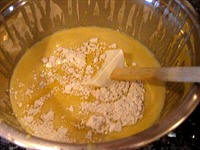
3. Beat the 12 egg whites until they are stiff and glossy: Use a stand mixer when you have a large amount of whites to beat, such as this recipe.
A. Place egg whites in a clean, dry grease-free mixer bowl of a stand mixer. Make sure there are no egg shells in the mixture.
SARAH SAYS: You can whip the egg whites if they are still cold. The real issue with egg whites is their freshness, not temperature, so you can beat whites right from the refrigerator, although they may require slightly more beating time. Newer fresh eggs have thicker whites and will reach more volume and have greater stability when beaten than older eggs.
B. With a stand mixer fitted with a whisk attachment, beat egg whites on low until foamy.
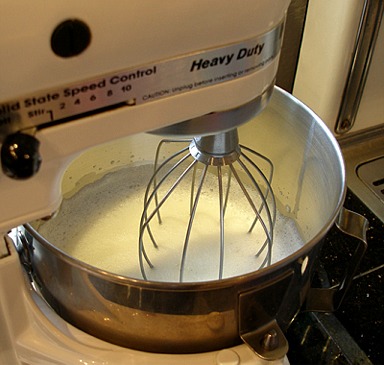
SARAH SAYS: As air is beaten into the egg whites, they will start to lighten in color. This beginning step is one of the most overlooked and important steps. If egg whites are beaten too quickly at the beginning, the structure of the foam will not be as strong, and later the egg whites will not beat as high as they should.
Keep mixing the egg whites on low speed. The egg white foam will increase in volume and become white and have large bubbles.
C. With the mixer running, immediately add the cream of tartar at the side of the bowl.
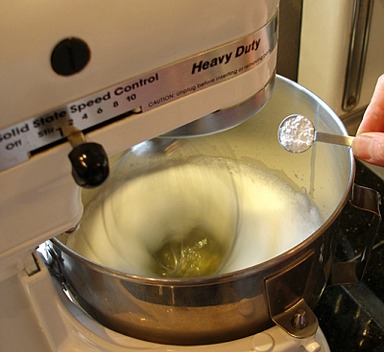
SARAH SAYS: Adding a small amount of acid, such as cream of tartar, lemon juice or vinegar, stabilizes egg whites and allows them to reach their full volume and stiffness. It does this by making the egg coagulate faster.
D. The bubbles in the egg white foam will become smaller and more even in size. When it reaches this stage, increase the mixer speed to medium-high.
E. Then, add 3/4 cup sugar slowly in a steady stream at the side of the bowl. After the sugar has been added, increase the mixer speed to high.
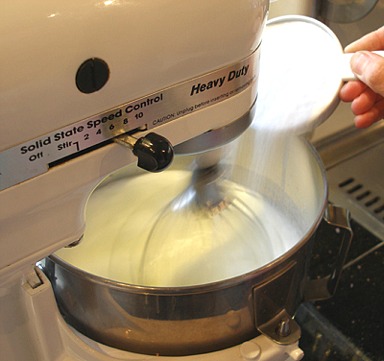
Always add sugar in a stream, slowly at the side of the bowl while the whites are being whipped; do not dump it in the center — you don't want to risk deflating the whites.
SARAH SAYS: I stopped the mixer so you could see how the egg white foam is beginning to become glossy. This is called the soft peak stage. It is reached when the peaks of the whites droop slightly, when the beater is turned off and lifted.
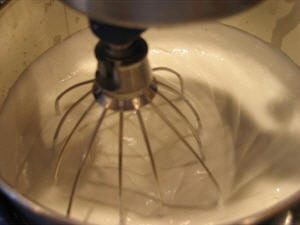
But, this recipe calls for beating the whites to the stiff peak stage…so keep beating with the mixer on high.
F. Beat until the egg whites are white, fluffy, very stiff and still very glossy.
For this recipe, the whites should be stiffer than most. They will form lumps as the mixer beats. STOP beating when they start to form lumps around the beater as shown in the photo.
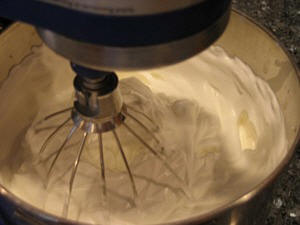
To test if properly beaten to the stiffly beaten stage, take the mixer bowl from the mixer or lift the beaters. You can gently cut a table or icing knife through the middle of the beaten egg whites; it creates a narrow grove with stiff walls. If not, continue beating for a few seconds more and perform the test, again.
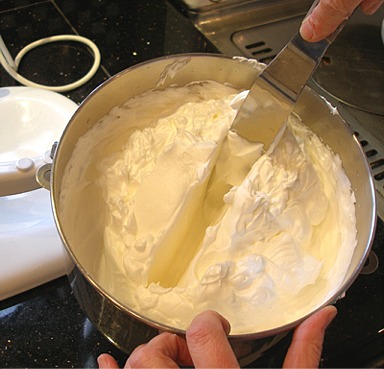
SARAH SAYS: Another test to perform to see if your egg whites are stiffly beaten are to stop the beaters and then lift them — straight and stiff peaks should form.
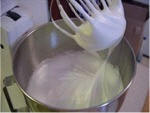
HELP! I've overbeaten my egg white mixture. Do I have to throw them out and start again! I just wasted twelve eggs and all of the time separating them…I'm heart broken!
RESCUE: Do not overbeat the egg whites; if they are beaten too stiff, they lose their gloss and look curdled. Unfortunately, there is no more stretch left for them to rise when baked — some or will pop during the whipping stage and will collapse. To fix, try whisking in another egg white with a wire whisk — DO NOT use the electric mixer. If you can't fix them, unfortunately, you have to start over again with fresh egg whites…
4. Fold the egg whites and the batter mixture until thoroughly blended:
SARAH SAYS: When you fold the batter and beaten egg whites together, they must be thoroughly blended together; you need to make sure all of the air bubbles are encased in batter, otherwise the cake won't rise properly. The batter will set around the air bubbles when the cake bakes in the oven, allowing it to puff properly. In essence, the folding action breaks up the air bubbles into smaller ones and encases each one in batter, like putting mortar in between small tiles to hold them in place. If the “mortar” isn't evenly distributed between the “tiles” and you have some large and small tiles, you'll get an uneven looking “floor” or cake crumb. Some “tiles” or air bubbles will be “loose” or escape from the cake batter and cause large holes in the cake. You'll see a pattern of “tiles” or egg whites grouped together separately from a layer or “mortar” or batter grouped together. Your “floor” or cake will be uneven and won't rise as high in the oven. With foam cakes, it's normal to see some uneven air holes in the cake's crumb (inside), but not large pockets of air holes, egg whites and/or batter. That means that the folding action was not done enough or was done too much where you managed to pop a lot of air bubbles. Folding takes a lot of practice to get right.
A. To start, use the batter mixture that was previously set aside. Stir it a few times to mix it thoroughly before using.
With a large rubber spatula, gently scrape 1/3 of the beaten egg whites on top of the mixture. Never add the batter to the whipped whites or the heavier mixture on top of the lighter, beaten they'll deflate.
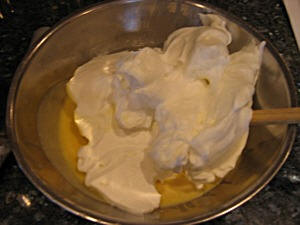
B. With the rubber spatula, in a large circular sweeping motion as if you are turning a crank, lightly combine the egg whites and batter. Do this one or two times. Be sure to scrape the bottom of the bowl.
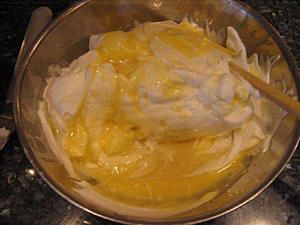
C. Starting on the top, cut down from the center of the mixture to the bottom of the bowl, then draw the scraper quickly towards yourself against the edge of it, and up to the left and out. You are thus bringing a bit of the mixture at the bottom of the pan up over the egg whites or “folding it over”. Then turn the bowl a quarter turn and repeat until you only see slight streaks of white. You will need to scrape the sides of the bowl a few times to keep the mixture from climbing up the sides.
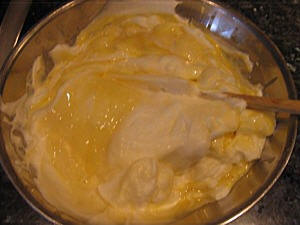
D. Repeat with the last two additions.
E. Fold the last of the egg whites and the batter mixture until almost completely combined. You'll still see a few streaks of eggs whites. The batter and egg mixture will become smoother.
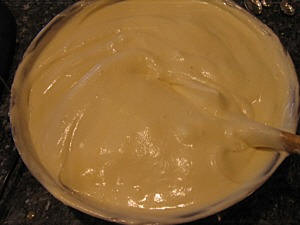
F. Sprinkle the chocolate chips evenly over the top. Fold until all are combined.
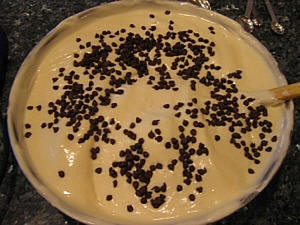
G. Continue the folding movement while slowly rotating the bowl, and cutting down, towards yourself, and out to the left, until the egg whites have been folded into the body of the batter. You shouldn't see any streaks of batter and eggs whites in the mixture and the chocolate should be evenly dispersed. The mixture should be smooth. Sometimes you'll see with a few small lumps visible; it just means that you slightly overwhipped the egg whites. Do not continue to fold the mixture because you'll start to remove the air from the batter.
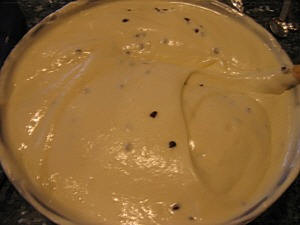
5. Bake the cake:
A. Immediately scrape batter into the prepared pan. The batter will fill close to the top of the pan. Run a table knife or thin icing spatula through the batter in an “s” formation so large air pockets will break-up into smaller ones. It will also break up any egg white clumps. The rest will dissolve into the batter. DO NOT bang the pan on the countertop because this eliminates air from the batter, which you don't want to do!
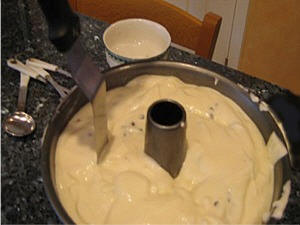
Gently smooth the top with a rubber spatula. Clean off the extra batter on the sides of the pan with a wet paper towel.
Immediately place the cake in a well-preheated 350 degree F oven.
B. Bake for 40 to 45 minutes or until the cake is a deep golden brown on top and springs back when touched lightly with the open palm of your hand – avoid poking the cake because you'll create dents. Insert a long wooden skewer in the center and it should come out with no batter attached or perhaps a tiny moist crumb or two. The top will crack during baking – it's ok. To further test for doneness, also poke the cake with a wooden skewer in its cracks because that's where the cake can still be underdone! Do NOT overbake or the cake will start to shrink from the sides of the pan and taste eggy.

C. When done baking, remove the cake from the oven and immediately turn the pan over the neck of a neck of a soda or wine bottle, or funnel, which I prefer to use – it is more stable than a bottle. This is just a demo of what it should look like, that's why you can't see any cake – there isn't any in the pan at the moment!
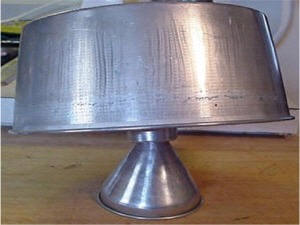
SARAH SAYS: Do not use the little tabs on top of the pan to rest the cake on to cool; it will not raise the cake high enough from the countertop to cool and will cause condensation to form on top of the cake. This will cause a sticky cake top!
Proper cooling is just as important as baking. The cake is inverted in its pan to cool which prevents its structure from shrinking or falling, giving it the open texture that's characteristic of these cakes. If placed to cool on a rack, it would deflate much of that hard-earned volume.
UNMOLD AND SERVE
Unmold the cake:
(See Grandma's Angel Food Cake Recipe for photos showing unmolding a foam cake from a two-part tube-pan.)
When the cake is completely cool, typically taking about two hours, remove it from its pan. Have the plate you will serve the cake off of ready to go.
Loosen the sides with a long metal spatula and remove the center core of the pan. Dislodge the bottom and center core with a thin–bladed, flexible knife. To keep the sides attractive, press the knife against the sides of the pan, moving the knife firmly in one direction; do not use a sawing motion. Invert onto a greased wire rack and reinvert onto a serving plate. Wrap airtight.
SERVE
The beauty of this cake being about 5-inches tall is dramatic enough to serve as is. Cut the cake into slices with a serrated knife and make small, quick sawing motions. Serve cake pieces with fresh peach slices or fruit or alone. I like to dust my slice with confectioners' sugar through a fine strainer and garnish with fresh mint.
SARAH SAYS: Look carefully and closely at the cake's crumb. It should have small, irregularly shaped air holes and there shouldn't be any streaks of egg whites visible; the cake should be a homogenous color. The texture should be “spongy” and springy when lightly pressed.
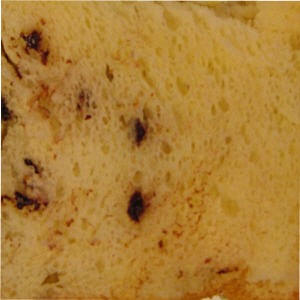
STORAGE
It will keep for about 3 days at room temperature, and 10 days refrigerated. Refrigerate if filled or frosted with perishable items, where it will keep for a few days because the filling and frosting only lasts that long. Chiffon cakes can be frozen for two months or so, but suffer somewhat in texture when thawed. It's best to freeze cake before unmolding from the pan. Wrap pan in foil before doing so.
VARIATION
Mocha Chocolate Fleck Chiffon Cake
Ingredients: Replace the 1/2 cup of the water with Kahlua or Tia Maria or any coffee-flavored liqueur. (Also, add in 1/4 cup cold water to equal 3/4 cup liquid TOTAL). Add in 2 teaspoon instant espresso powder with the flour and dry ingredients.
Prepare and bake as directed. Serve each slice with a dusting of powdered sugar through a fine mesh strainer.
Questions and Answers:
Question: I ran out of vegetable oil. Can I just use melted butter instead?
SARAH SAYS: Melted butter and vegetable oil are NOT INTERCHANGEABLE. You can substitute one oil for another, such as safflower for canola (not olive oil because it’s too heavy for this type of cake), or a solid fat, such as shortening, with another solid fat, such as stick butter. But, you can’t substitute melted butter with oil, unless it’s used for lubrication purposes only, as in greasing a baking pan.
Here’s why: Oil and melted butter have different properties, and small changes in fats in a recipe will make a big difference. The chemical composition of each is quite different; hence the textural results would not be the same. Butter contains about 18% moisture, 78% fat and about 1.5- 2.0% milk solids and salt. Oil is 100% fat and also doesn’t provide moisture to create steam or help in the gluten-forming process. (Gluten is the protein created from wheat flour when mixed with a liquid, and it provides structure for baked goods). Plus, they have different melting points from one another, playing a different role in the batter during the baking process. The milkfat in butter gives it its unique properties. In baking recipes, butter contributes a distinct flavor that oil does not, as well as tenderness, structure, color and flavor release. Oil contributes tenderness by coating the flour thereby protecting it from moisture and from making gluten. Oil tenderizes the gluten strands in a recipe, but not as effectively as butter. Oil reduces dryness and enhances flavor, and has the same number of calories and fat grams as butter, but it has less saturated fat. Solid fats differ from oils in that they are solid at room temperature or become solid after melting, while oils always stay liquid. Because of this, a chiffon cake stays soft and keeps longer.
Question: Which one – A hand-held electric mixer or a stand mixer ? (Never use a blender.)
SARAH SAYS: Beaters can make a difference in volume depending upon the number of egg whites beaten at one time. (Small amounts 4 large egg whites; large amounts 5 or more). Some classicists use a large balloon whisk and a copper bowl, when beating by hand for small and large amounts. I prefer to use a hand-held electric mixer only for beating small amounts. With it, I can move the beaters to reach all of the foam which gives me the best possible volume. When I have large amounts of egg whites to beat, I use my stand mixer because I need more power. The only problem with it is the beaters do not quite reach the bottom of the bowl, a bigger problem whipping a small amount of egg whites.
Question: Why do some recipes say to “make a well” in the center of the dry ingredients and some don't?
SARAH SAYS: By making a well in the dry ingredients, the liquid ingredients can be incorporated much quicker into the batter. The less time it takes to stir moistened flour, the less gluten or toughness in a recipe is formed. This is commonly seen in making biscuits and muffins where there isn't a lot of fat in the recipe or where the flour isn't coated with fat before adding the liquid ingredients to prevent a lot of gluten from forming. Some cake recipes, such as this one, follow this technique, as well.


